
Bespoke investment solutions are continuing to gain traction with large European insurers and pension schemes, according to new research.
Research by Cerulli Associates found investment managers see bespoke solutions for institutions as a key revenue generator over the next 12 to 24 months.
At a time when institutions are under escalating pressure to optimize investment portfolios to meet their long-term funding requirements, Barbara Wall, Europe managing director at Cerulli, said: “Many managers are adapting generic products to bring scalable customization to a wider investor base.”
Cerulli said the nature of the bespoke solutions on offer varies significantly depending on the size and type of investor.
While Solvency II, for example, has made the segregation and bespoke management of core insurer assets commonplace, customized strategies are being adopted in a less uniform way in the pension space.
Non-profits, meanwhile, tend to be more interested in customizing or segregating assets based on ethical constraints and preferences than in matching their liabilities.
Justina Deveikyte, an associate director at Cerulli, added: “Cerulli believes the management space is polarizing into large players offering bespoke solution-style management for key accounts and a second tier of managers offering what could be called ‘off-the-shelf customization.”
Cerulli’s research also found that with future return expectations for a traditional 60%/40% equity/bond portfolio below the return targets of most institutional investors, many in the US are turning to more illiquid private investments – private equity, private debt, private real estate, and infrastructure – to meet their long-term return goals.







